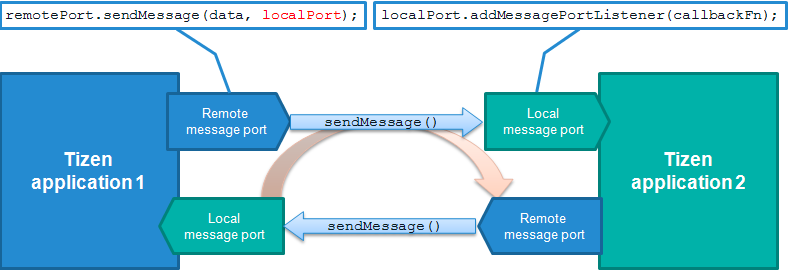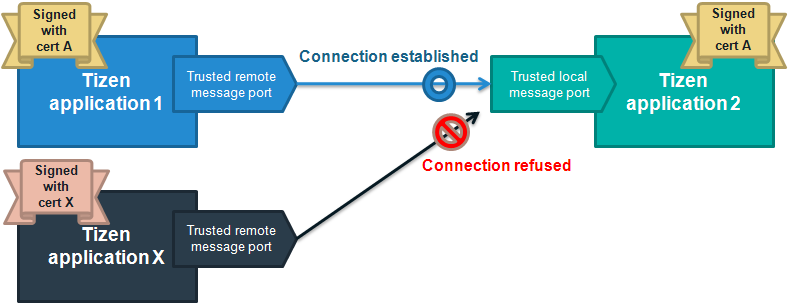Message Port
Your Web applications can communicate with other Web or native applications. The message data type for the communication is map data, which consists of a string key and value that can be a string, string array, byte stream, or byte stream array.
The Message Port API is mandatory for Tizen Mobile, Wearable, and TV profiles, which means that it is supported on all mobile, wearable, and TV devices. All mandatory APIs are supported on the Tizen emulators.
The main features of the Message Port API include the following:
-
Sending messages
A Tizen Web application can send messages to another application using the
sendMessage()method of theRemoteMessagePortinterface (in mobile, wearable, and TV applications). -
Receiving messages
To receive response messages from another application, your application can specify a local message port when it sends a message. You can receive response messages using the callback method which is registered through the
addMessagePortListener()method of theLocalMessagePortinterface (in mobile, wearable, and TV applications).You can mostly receive message from applications implemented as Tizen native or Web applications. To implement a native application, see the native Message Port Communication guide.
Figure: Sending and receiving messages

-
Using trusted message ports
For added security, you can restrict communication to only exchange messages with a trusted application that is signed with the same certificate as your application. Use the instances of the
LocalMessagePortandRemoteMessagePortinterfaces that are retrieved by therequestTrustedLocalMessagePort()andrequestTrustedRemoteMessagePort()methods of thetizen.messageportobject.Figure: Trusted message ports

Manage message ports
You can send and receive messages through 2 types of message ports:
-
The
LocalMessagePortinterface (in mobile, wearable, and TV applications) is used to register your message port and prepare to receive messages from other applications.To receive messages from other applications, you must register a callback to the local message port.
-
The
RemoteMessagePortinterface (in mobile, wearable, and TV applications) is used to send messages to other applications.The local message port information can be sent to another application for bi-directional communication, to enable the other application to send response messages.
You can retrieve the instances of the LocalMessagePort and RemoteMessagePort interfaces with the requestLocalMessagePort() and requestRemoteMessagePort() methods of the tizen.messageport object.
Learning how to send messages to and receive responses from other Tizen applications through message ports is a basic data communication skill:
-
To create a local port which receives messages, use the
requestLocalMessagePort()method of theLocalMessagePortinterface:var localPort = tizen.messageport.requestLocalMessagePort('SAMPLE_PORT'); -
To retrieve an instance of the
RemoteMessagePortinterface, use therequestRemoteMessagePort()method of thetizen.messageportobject. TheRemoteMessagePortinterface sends messages to the port identified by anApplicationIdand a port name:var targetApplicationId = tizen.application.getCurrentApplication().appInfo.id; var remotePort = tizen.messageport.requestRemoteMessagePort(targetApplicationId, 'SAMPLE_PORT'); -
Use the
addMessagePortListener()method of theLocalMessagePortinterface to add a callback method that is invoked when the message arrives:var localPortWatchId = localPort.addMessagePortListener(function(data, replyPort) { for (var i = 0; i < data.length; i++) { var key = data[i].key; switch (key) { case 'command': console.log('key:' + key + ' / value:' + data[i].value); break; case 'data': case 'byteData': console.log('key:' + key + ' / value:['); for (var j = 0; j < data[i].value.length; j++) { console.log(data[i].value[j] + ', ') } console.log(']'); break; case 'bytesData': console.log('key:' + key + ' / value:['); for (var j = 0; j < data[i].value.length; j++) { console.log('['); for (var k = 0; k < data[i].value.length; k++) { console.log(data[i].value[j] + ', ') } console.log(']'); } console.log(']'); break; } } if (replyPort) { console.log('replyPort given: ' + replyPort.messagePortName); } }); -
Use the
sendMessage()method of theRemoteMessagePortinterface to send a message:var messageData = [ {key:'command', value:'begin'}, {key:'data', value:{'dummy1', 'dummy2'}}, {key:'byteData', value:[12, 23, 34, 45, 56, 67, 78]}, {key:'bytesData', value:[[1, 2, 3, 255], [8, 9, 3, 4, 5]]} ]; remotePort.sendMessage(messageData);If you expect a response message, pass the instance of the
LocalMessagePortinterface as the second parameter of thesendMessage()method to specify the message port where the response is sent:remotePort.sendMessage(messageData, localPort);
Related information
- Dependencies
- Tizen 2.4 and Higher for Mobile
- Tizen 2.3.1 and Higher for Wearable
- Tizen 3.0 and Higher for TV